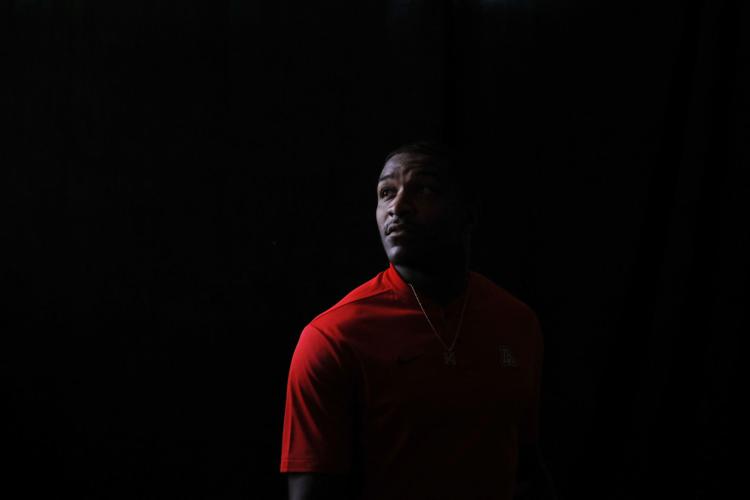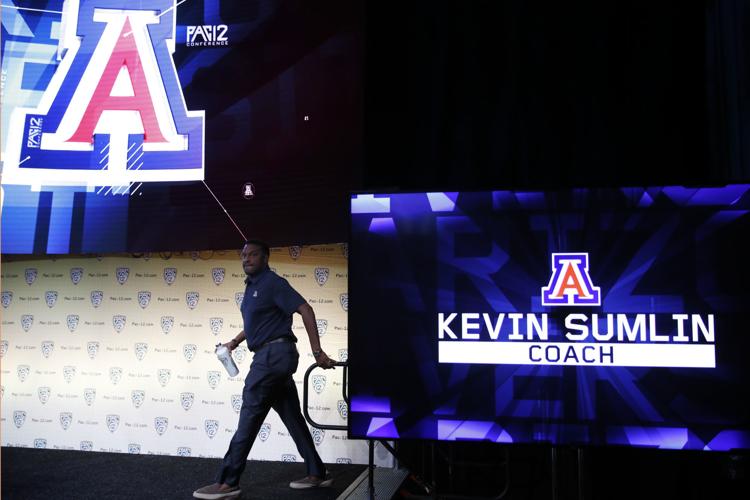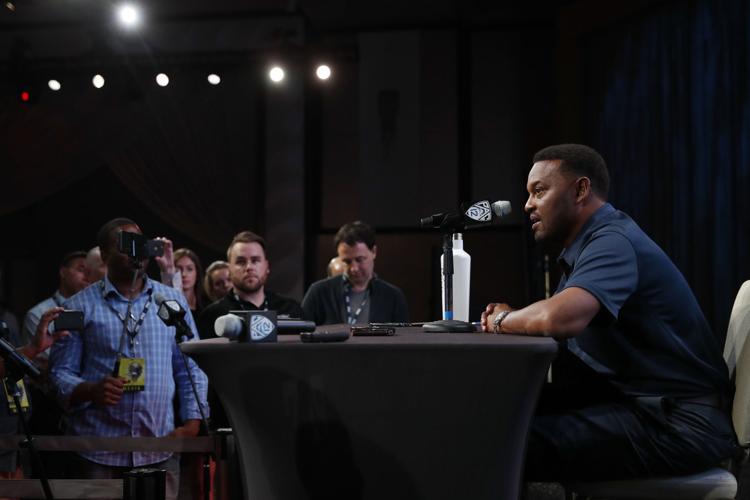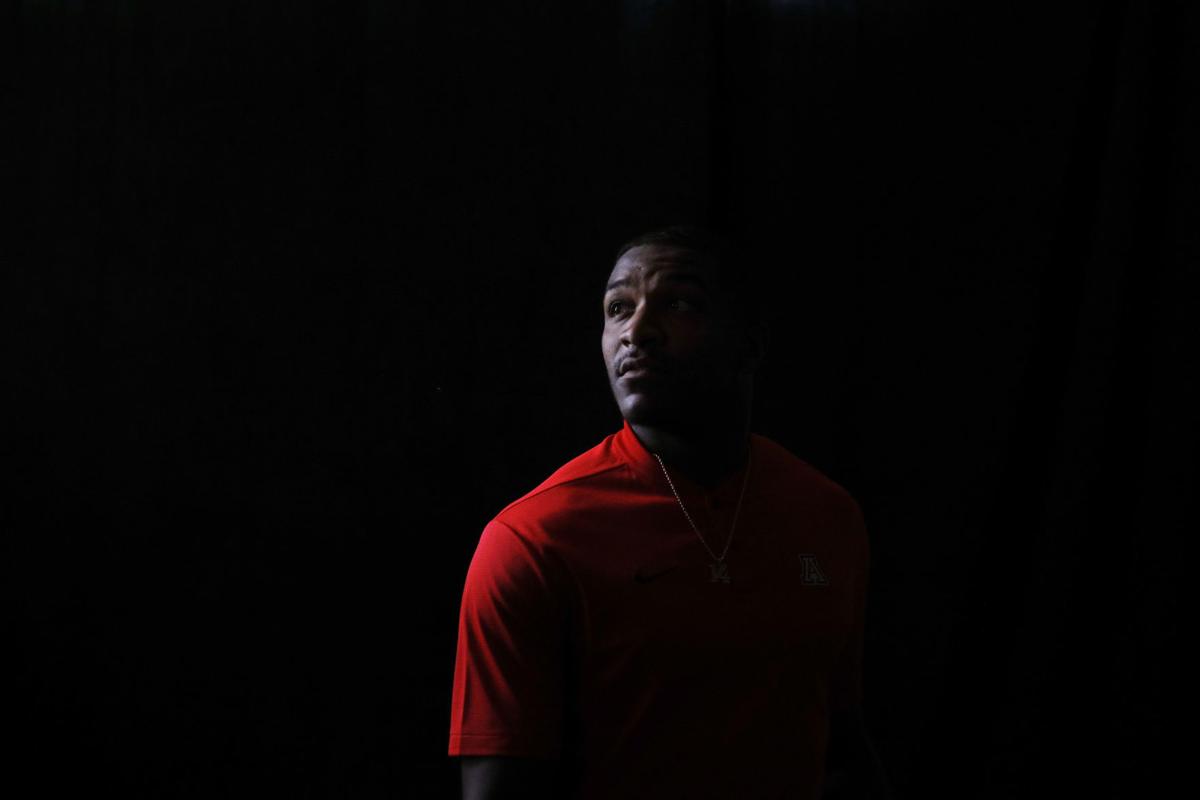LOS ANGELES — A year ago, Khalil Tate was Arizona’s backup quarterback — a four-star recruit, a local legend but still a relative unknown.
A year later, Tate represented the Wildcats at Pac-12 Media Day. No one could have seen that coming last summer, including Tate himself.
“No,” Tate said Wednesday amid a throng of reporters. “I’m the type of person, I like to take it day by day.”
One day last October, Tate’s life changed. He replaced the injured Brandon Dawkins at Colorado, rushed for an FBS-record 327 yards and became a true overnight sensation.
After winning an unprecedented four straight Pac-12 Offensive Player of the Week awards, and finishing 2017 with 1,411 rushing yards, Tate popped up on every preseason list of potential Heisman Trophy candidates. He appeared on magazine covers. Pundits gushed about his dual-threat talents.
Fame, Tate is discovering, has its costs.
“It’s a lot more attention,” the junior conceded. “I’ve never been the type to like attention like that. I’m kind of shy. I kind of have to do it because I’m the quarterback now. It’s something I’m getting used to.”
Fortunately, Tate has an ally who has helped guide other quarterbacks through the minefield.

First-year Arizona coach Kevin Sumlin was in Los Angeles for Pac-12 Media Day on Wednesday, along with Heisman candidate Khalil Tate and sophomore linebacker Colin Schooler.
First-year UA coach Kevin Sumlin has helped tutor three Heisman Trophy-winning quarterbacks: Jason White, Sam Bradford and Johnny Manziel.
“Managing the outside noise is something you have to help guys with and help families with,” Sumlin said. “Fortunately, I’ve been around enough of these guys to have been through it and had some success.”
Sumlin came away impressed with the way Tate handled himself Wednesday. He faced a barrage of questions, including several about a mini-controversy that bubbled to the surface Tuesday (more on that later).
“Today is a big step for him,” Sumlin said. “He looked real relaxed and comfortable.”
As he did during spring, Sumlin was quick to remind everyone that Tate remains relatively inexperienced. He’s still only 19 years old, and he has yet to start a full season’s worth of games.
He has a lot to learn — and plenty of room for growth.
“What’s important is that his body of work is not extensive,” Sumlin said. “He is a very inexperienced guy that can get better.
“For a guy that’s played as few snaps as he’s played to be talked about for postseason awards is really a remarkable situation. We’re here to help with that and manage that.”
Sumlin considers the leadership component to be as critical as any in Tate’s development. Sumlin also considers Media Day to be a valuable exercise in that regard. Tate was joined by another first-timer, sophomore linebacker Colin Schooler.
“It was a great experience for them,” Sumlin said. “What people were so impressed with was how mature they were for young guys. They handled themselves with poise. That’s part of growing up. That’s part of leadership.”

Sumlin, who’s coached Johnny Manziel, is no stranger to dealing with quarterbacks engulfed in controversy. A report this week suggested that a tweet by Khalil Tate led the UA to hire Sumlin.
Being a leader also means dealing with uncomfortable situations. Tate made headlines Tuesday when he implied to Bleacher Report that he had a say in Arizona’s decision to hire Sumlin — and not hire Navy’s Ken Niumatalolo.
When it was reported that Niumatalolo was the leading candidate for the job, Tate tweeted his disdain for the triple-option offense Navy runs. Tate subsequently deleted the tweet.
Tate told Bleacher Report that he wanted to make sure his voice was heard and described himself as the spokesman for the team during the coaching search. Two days after Tate’s tweet, Arizona hired Sumlin.
Tate said Wednesday that the story went too far in connecting the dots.
“It sounds kind of funny; it sounds kind of fishy,” Tate said. “It sounds like I made the decision when I did not make the decision.”
Tate said he did speak with UA athletic director Dave Heeke and school president Robert C. Robbins during the search.
“They basically told me what was happening, told me the situation, what was going on,” Tate said. “They gave me … the rundown of what, why and who. I was just all ears listening to them.”
If Bleacher Report didn’t completely capture Tate’s role, how would he summarize it?
“We were looking for a head coach,” he said. “I’m one of the leaders of the team. We just wanted to find out who was going to be the head coach.”
Schooler said he spoke to Robbins briefly during the process. Schooler described that conversation as an exchange of ideas.
“Dr. Robbins and Dave Heeke, they were going to choose whoever they wanted to choose,” Schooler said. “They just listen to what the players have to say. They’ll take your input on it.
“But it was nowhere near, ‘Who do you want?’ It was, ‘What do you think we need?’ I definitely didn’t throw names at him.”
Heeke made clear Wednesday that while he welcomes and seriously considers the input of student-athletes, he makes the ultimate call when it comes to hiring coaches.
“Throughout the entire process, whether it was Khalil or other leaders in our football program, we were in conversations with them,” Heeke told the Star.
“At the end of the day, it’s my responsibility, my duty and role as the athletic director to select the head coaches in a program. I value the input and the comments from our student-athletes. It’s their experience. It’s very impactful to them. But again, while very important, that’s only one factor that goes into making sure we have the right kind of leadership.”
Some interpreted the sequence of events as described by Bleacher Report — Tate’s tweet and Arizona’s apparent pivot from Niumatalolo to Sumlin — as undermining Heeke’s authority. He refuted that notion.
“Khalil and I have a great relationship,” Heeke said. “Speculating and hypothesizing about the decision-making process, without any knowledge of it, is, in my opinion, inappropriate and unfounded.”
Regardless of how it all went down, Sumlin ended up in Tucson, uniting a coach who has Heisman experience with a quarterback who has Heisman potential. Tate found it “shocking” to see his name on those lists.
“My whole life I’ve kind of been the person that’s in the back, not getting that type of limelight,” he said. “Everything I’ve worked for in the past is finally coming to fruition.”
But how does he make it a reality? Tate goes back to that day-by-day approach.
“If you look too far ahead,” he said, “then you’re probably going to end up messing up.”







